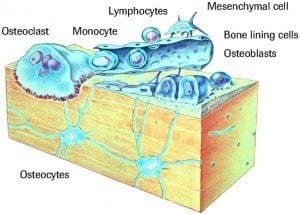 It’s not often that you hear of medical science discussing diabetes and bones in the same sentence. Usually the heart and kidneys are the discussed in connection with diabetes, but new research suggests that the human bones may have a bearing on how the human body manages insulin.
It’s not often that you hear of medical science discussing diabetes and bones in the same sentence. Usually the heart and kidneys are the discussed in connection with diabetes, but new research suggests that the human bones may have a bearing on how the human body manages insulin.
MedPageToday indicates, “In the July 23 issue of Cell, [and] from two separate research teams [there is an indication] that insulin receptors in osteoblasts mediate release of the hormone osteocalcin, which speeds up glucose metabolism elsewhere in the body.”
MedicineNet.com defines osteoblasts as, “A cell that makes bone.” Meanwhile, “The hormone osteocalcin is secreted solely by osteoblasts (bone making cells) and thought to play a role in the body’s metabolic regulation and is pro-osteoblastic, or bone-building,” according to Wikipedia.
According to Gerard Karsenty, MD, PhD, of Columbia University in New York City, “The two studies suggest that drugs working through the osteocalcin pathway, if not the hormone itself, could be effective treatments for type 2 diabetes.
“Insulin signaling in osteoblasts [is] a critical link between bone remodeling and energy metabolism,” cited MedPageToday.com
The exciting part of this research is the fact that this provides a new link of potential in how the body works to correct health issues. As mentioned in the opening paragraph it is not often that anyone has spoken about diabetes and bone health in the same sentence.
The end result could be that individuals with diabetes may want to gain as much information about how the human bones can actually help regular blood sugar (glucose) as possible.
MedPageToday indicated these, “experiments also revealed what they called a “previously unappreciated” function of insulin in bone — that it boosts activity of an osteoblast regulatory molecule called Runx2, the end effect being that insulin helps promote osteoblast differentiation.”
The research on this finding was “funded by the Fond de la Recherche en Sante du Quebec, the National Institutes of Health, and the Juvenile Diabetes Research Foundation.”
The long and short of the research suggests that it is possible the bone making cells interact in a more significant way with diabetes by infusing the hormone osteocalcin into the body. This hormone is helpful in regulating diabetes. The hormone appears to act in concert with the bone-making cells to create an atmosphere that is equipped to help with the in-body care needed to thrive with diabetes.
According to MedPageToday both research groups suggested, “In total, the findings demonstrate the delicate and interactive nature of the processes underlying bone formation and resorption.”
The research may further indicate what possible ways this knowledge can be used to accelerate the body’s ability to accept a more efficient flow of information and successful implementation and absorption of insulin within the body, and used by bone making cells.
The body is a very complex organism that is often discovered to be more complex than we ever realized. DNA is an example of the complexity, but even within that undeniably unique set of body blue prints we continue to learn more and more about not only the various parts of our internal structure, but also how those parts interact in ways we never imagined.
These latest studies remain a prime example of how that plays out in scientific data and potential medical fixes for those occasions when two parts of the body that normally work well together are in the midst of a struggle.